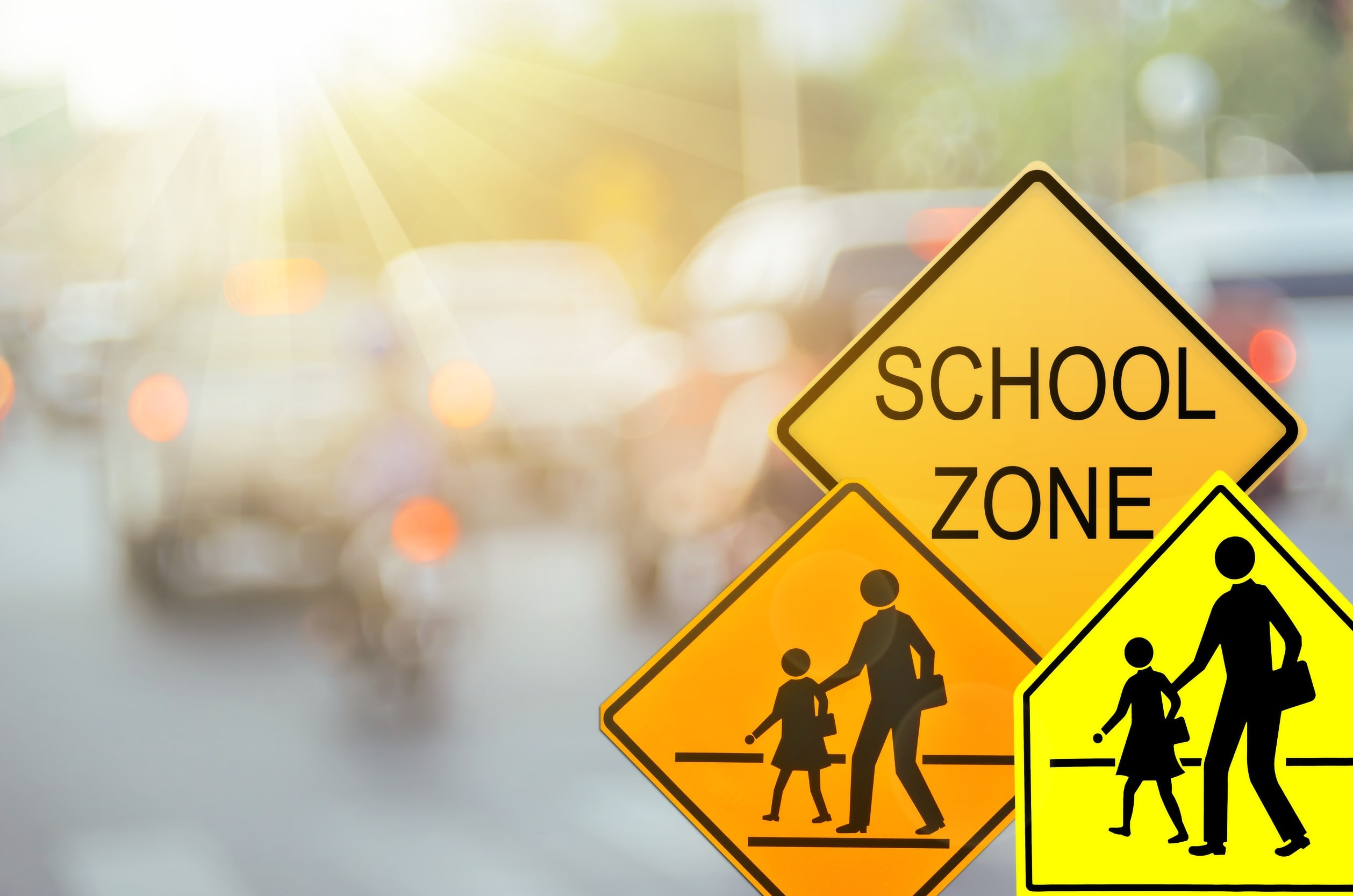Keeping School Traffic Safe: What You Need to Know
As the school year begins, neighborhoods and school zones become bustling with pedestrian activity. With parents and children navigating to and from school buses,

As the school year begins, neighborhoods and school zones become bustling with pedestrian activity. With parents and children navigating to and from school buses, the importance of traffic safety in these areas cannot be overstated. Paying attention to school traffic laws not only helps prevent accidents but can also save you from higher insurance premiums. This blog will explore key traffic laws, the impact on your insurance, and tips for driving safely around schools.
Key Takeaways
Understanding and adhering to traffic laws in school zones is crucial. Passing a stopped school bus is illegal in all states and can result in hefty fines. School zones generally have reduced speed limits, and speeding in these areas can significantly increase your car insurance rates. Additionally, it’s vital to ensure you’re driving cautiously around stopped buses and crosswalks to protect students and other pedestrians.
What Are the Most Common Traffic Laws Around a School?
Passing a Stopped Bus
In every state, passing a stopped school bus when it is loading or unloading children is illegal. The fines for this violation can be substantial. For instance, in California, fines range from $150 to $1,000, while in Massachusetts, they can be as high as $2,000. Repeated offenses might lead to even more severe consequences, including potential jail time or license revocation. The importance of this law cannot be stressed enough, as it is designed to protect children who are most vulnerable during these crucial moments.
School Zones
School zones are designated areas around schools where reduced speed limits are enforced to ensure the safety of children and pedestrians. These zones can extend from 200 to 500 feet from school grounds or crosswalks, and the speed limits usually range between 15 to 25 miles per hour. The exact limits can vary depending on local laws, but it’s essential to adhere to the posted speed limits to avoid accidents and potential fines.
Cellphone Use
In several states, using a cellphone to make calls or text while driving is illegal, particularly in school zones. States such as Arkansas, Florida, Louisiana, and Texas enforce stricter regulations in these areas to minimize distractions and enhance safety. Familiarizing yourself with the laws in your state can help avoid fines and improve overall road safety.
How To Drive Safely Through School Traffic
Slow Down and Obey Traffic Laws
Driving through school zones requires extra caution. The reduced speed limits, typically between 15 to 25 miles per hour, are set to lower the risk of severe injuries or fatalities in the event of a pedestrian-involved crash. At higher speeds, the likelihood of severe outcomes increases dramatically. By adhering to speed limits and traffic laws, you not only avoid tickets but also play a crucial role in safeguarding students and pedestrians.
Practice Being a Courteous Driver
Aggressive driving behaviors can lead to accidents and exacerbate dangerous situations. It’s important to stay calm and patient, giving others the right of way as appropriate. This includes waiting for children and elderly pedestrians to cross safely, and being mindful of any unexpected behavior from pedestrians. Demonstrating courtesy on the road helps create a safer environment for everyone.
Stop for Buses
When a school bus is preparing to load or unload children, it typically flashes yellow lights as a warning. When the bus activates red lights and extends an arm with a stop sign, it indicates that children are boarding or alighting. It’s illegal to pass the bus at this time. You should wait until the lights stop flashing and the bus resumes motion before proceeding. Giving the bus a 10-foot space around it is also crucial, as this area is particularly hazardous for children. Ensuring the bus has completely resumed its journey before moving is essential to avoid accidents.
Avoid Stopping on Crosswalks
Stopping on top of a crosswalk can force pedestrians to walk around your vehicle, potentially putting them in harm’s way. It’s important to keep crosswalks clear to ensure pedestrians can cross safely without entering the path of oncoming traffic. This simple action can prevent accidents and ensure a smoother flow of traffic.
Pay Attention to Cross-Guards and Crosswalk Signals
Crossing guards play a vital role in school zones by helping students cross the street safely and alerting drivers to pedestrian activity. These guards are often equipped with reflective gear and stop signs to increase visibility. Additionally, crosswalk signals provide important indications that pedestrians may be crossing. Paying close attention to these signals and the presence of crossing guards helps in maintaining safety.
Keep Your Eye Out for Runners or Bicycle Riders
Be vigilant for runners and cyclists, especially in school zones. When stopped, ensure that all pedestrians have finished crossing the road before proceeding. Smaller children on bicycles or running may be less visible, so it’s important to give them ample space and be prepared for sudden movements. Many states have laws requiring drivers to give at least three feet of space to bicyclists, so keeping an eye out for them is not only considerate but also legally required.
Be Mindful of Children and Pedestrians
Children can be difficult to see, particularly from larger vehicles. Always leave space when stopping at a crosswalk to ensure you can see if any pedestrians are in front of you before moving. Younger children may not fully comprehend traffic rules or their surroundings, so it’s crucial to be extra cautious and observant.
Can a School Zone Traffic Ticket Impact My Car Insurance Rates?
Receiving a traffic ticket in a school zone can significantly impact your car insurance rates. Insurance companies view tickets as indicators of risky behavior, which can lead to increased premiums. On average, speeding in a school zone can increase your car insurance rates by 25%, while other traffic violations might cause an average increase of 49%. Most insurance companies consider traffic violations on your driving record for three to five years, although this can vary based on the nature of the violation and your state’s regulations. In some cases, a high-risk status could lead to your insurance company dropping your coverage or making it difficult to find new insurance.
FAQs
1. What should I do if I see a stopped school bus?
When you see a stopped school bus with its red lights flashing and the stop sign arm extended, you must stop your vehicle and wait until the lights stop flashing and the arm retracts before proceeding. Ensure that you give the bus at least 10 feet of space to accommodate children who are boarding or alighting safely.
2. How can I ensure I’m following school zone speed limits?
To ensure you are following school zone speed limits, always pay attention to posted speed limit signs as you approach school zones. Speed limits in these areas typically range from 15 to 25 miles per hour, depending on local regulations. Reduce your speed as you enter these zones and be prepared to stop for pedestrians and crossing guards.
3. What are the penalties for not following school zone traffic laws?
Penalties for not following school zone traffic laws can include hefty fines, points on your driving record, and increased car insurance rates. The fines can vary depending on your state and the specific violation. Repeated offenses might lead to more severe consequences such as license suspension or even jail time in some jurisdictions.
4. Can speeding in a school zone affect my car insurance rates?
Yes, speeding in a school zone can lead to increased car insurance rates. On average, speeding in these areas can increase your premiums by 25%. Insurance companies view traffic violations as indicators of risky behavior, which can lead to higher rates and potentially impact your ability to secure coverage in the future.
5. Are there specific laws about using cellphones in school zones?
In several states, using a cellphone to make calls or text while driving is illegal, especially in school zones. States like Arkansas, Florida, Louisiana, and Texas have stricter regulations in these areas to minimize distractions and enhance safety. It’s important to be aware of and comply with local laws regarding cellphone use while driving.
6. How should I drive around crossing guards and crosswalks?
When approaching crossing guards and crosswalks, reduce your speed and be prepared to stop. Crossing guards are there to help students cross the street safely, and they use reflective gear and stop signs to alert drivers. Always yield to pedestrians at crosswalks and follow the directions of crossing guards to ensure safety.
7. What should I do if a pedestrian or cyclist is crossing the road?
When you see a pedestrian or cyclist crossing the road, wait until they have completely finished crossing before proceeding. Ensure you give cyclists at least three feet of space, as required by law in many states. Being vigilant and patient helps prevent accidents and ensures everyone's safety on the road.
8. How long will a traffic ticket affect my insurance rates?
Traffic tickets can affect your car insurance rates for three to five years, depending on the nature of the violation and your state’s regulations. Insurance companies review your driving record during this period, and a history of traffic violations can lead to higher premiums or difficulty finding new coverage.
9. What are the risks of stopping on crosswalks?
Stopping on crosswalks can force pedestrians to walk around your vehicle, potentially putting them in the path of oncoming traffic. This increases the risk of accidents and can endanger pedestrians. Always keep crosswalks clear to allow safe passage for pedestrians.
10. Why is it important to be extra cautious around school zones?
Being extra cautious around school zones is crucial because these areas are frequented by young children who may not always follow traffic rules or be aware of their surroundings. By driving attentively and adhering to traffic laws, you help create a safer environment for students and other road users.
What's Your Reaction?


















